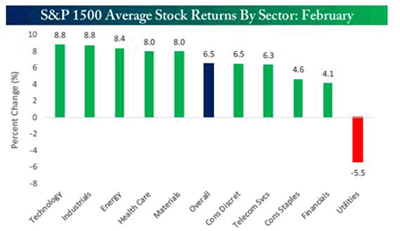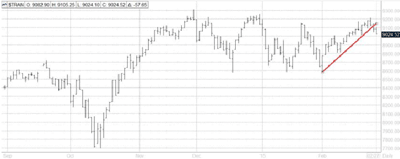by Jeffrey Saut, Chief Investment Strategist, Raymond James
Greetings from Orlando where the Raymond James 36th Annual Institutional Investors Conference is in full swing. At this year’s conference there will be more than 1,000 portfolio managers (PMs) and analysts, as well as more than 300 companies presenting. In a past life I used to attend many of Wall Street’s institutional investors conferences, but have come to like ours the best. The reason is because of the diversity of companies and the fact there are no market capitalization constraints. Attendees are able to see a small cap bank in one presentation and $20+ billion dollar Technology Company in the next. I will be seeing presentations from companies where I own stock. One company I was really looking forward to meeting with, not only because our analyst loves it but so does premier stock picker Ron Baron of Baron Capital fame, was Iridium Communications (IRDM/$9.58/Strong Buy). The reason Iridium will not be at the conference this year is because they are hosting an Analyst Day next week and did not want to preempt that event. In lieu of that meeting our analyst (Chris Quilty) had this to say last week:
Following strong 2014 results, 2015 is shaping up to be a pivotal year for Iridium as the company begins launching satellites, ramps up aero/maritime/DoD efforts, and introduces new products/services. By year-end, the story should be significantly de-risked, with accelerating growth and a higher valuation multiple. Accordingly, we reiterate our Strong Buy rating. For the fourth consecutive quarter, Iridium delivered better-than-expected quarterly results, reporting revenue and OEBITDA that exceeded expectations by 1% and 7%, respectively. For the full-year, Iridium grew OEBITDA 8% to $217 million, topping the company's original guidance of $205-215 million. Iridium added 52,000 M2M subs in 2014 (up 16% y/y) and management expects to achieve double-digit sub/revenue growth in 2015 aided by price cuts, new OEM contracts, and new applications/verticals. Likewise, the aero and maritime businesses are poised for double-digit growth and the voice business could see a significant boost from the launch of commercial push-to-talk services later in 2015.
Management affirmed its long-term service revenue growth forecast of 8-12%, but indicated that 2015 service growth will come in below trend (3-6% growth) due to: (1) a $3 million currency translation hit in Russia, (2) a $3 million headwind related to the wind-down of NATO operations in Afghanistan, and (3) foreign exchange-related demand weakness in the commercial voice product line. Given the transitory nature of these issues, we expect normalized growth to return in 2016. (Full Report - IRDM: Solid Finish to 2014; On Track to Tackle 2015 Headwinds).
This week, at least for me, it’s all about the conference. Last week, however, there was some good and bad economic news. Overall, of the 27 economic indicators released, 15 were weaker than expected. Nevertheless, speaking to the good, the GDP was better than estimated (+2.2% vs. +2.1%e), Durable Goods orders beat expectations (+2.8% vs. +2.0e) but missed excluding transportation, UoM consumer confidence improved (95.4 vs. 94e), New Home sales were above estimates (+3.2% above the y/y estimates), Home Purchases Applications rose by 4.6% after four weeks of declines, and there was a rise in the Market PMI Services Index for February to 57 for its best reading since October 2014. On the negative side, the Chicago Manufacturing PMI bombed (45.8 from 59.4), the Dallas Manufacturing Index slid (-11.2 from – 4.4), the Richmond Manufacturing Index fell to zero from +6, Initial Jobless Claims increased (313k vs. 282k the prior week), Existing Home Sales were 130,000 less than expected (the lowest since April), the February Consumer Conference Confidence Board fell to 96.4 from 103.8, and 2014’s annualized GDP growth averaged only 2.45%.
Our economist, Scott Brown Ph.D., had this to say about some of these reports:
This isn’t a sign of weakness. The revision was due largely to slower inventory growth (which is a good thing – leaner inventories pave the way from better production). The trade deficit was a bit wider, but not as much as anticipated. Domestic Final Sales, the preferred measure of underlying domestic demand, was revised higher – and if you exclude government, a 3.5% annual rate, vs. +3.3% in 3Q14 (economic growth DID NOT weaken in 4Q14).
However, as I drill down into the figures, at 2.2% for the 4Q14 the nation’s GDP lost roughly 280 basis points (bp) of growth from the 3Q14’s ~5% growth rate. So let’s see where the shortfall was, Personal Consumption Expenditures were up (+62 bp), Gross Private Investment lost 34 bp, Net Exports of Goods and Services swooned by 193 bp, and Government Consumption Expenditures and Gross Investment declined 112 bp. There, ladies and gents, is the 277 bp difference. I suspect the wicked weather, the West Coast dock workers’ strike, and the strong U.S. dollar had a hand in the GDP’s descent, but it sure looks like spending was down on durables. Now one quarter’s report does not a trend make, so it will be interesting to see what happens in this year’s first quarter. To that point, I agree with my friend David Kotok, captain of Cumberland Advisors, who wrote (as highlighted in last week’s Morning Tack):
According to Fundstrat's estimate, the negative impact on S&P 500 earnings in 2015 will be $4.63. The positive impact on S&P 500 earnings will be $10.04. Thus the net impact is a positive $5.41. That is, the overall impact of lower energy prices on S&P 500 earnings in 2015 will be an improvement of $5-plus per S&P 500 share. Energy prices fall; the Energy sector is hurt; the rest of the economy improves; the net effect is positive. That is the conclusion of Fundstrat. We agree with them. . . . Remember that this stock market effect is inter-temporal. There is the immediate down shock and the lag time to the positive outcome is two to three quarters. That is why Barclays is forecasting acceleration of [economic] recovery as the year progresses. We agree. Also, how does one price this shift of $5 in S&P earnings? Is it temporary, or is it more permanent? If temporary, the pricing change is small. If permanent, one could price it at 18-20 times, or a 5% permanent upwards shift in the S&P 500 Index trend baseline.
Following that prose I wrote, “Boy, if that sounds familiar it should because I have argued that according to Ben Graham's P/E formula, or the Rule of 20's formula, price/earning's ratios (P/Es) should be higher than where we trade currently. In fact, according to those two metrics, the S&P 500's (SPX/2104.50) P/E should be somewhere between 18.5 and 20.5, suggesting price targets for the SPX, even given (IMO) the overly reduced S&P estimates ($118.32), approaching ~2189 and ~2425.”
For the month of February, all of the major indices I track were up by 5% or more. On a sector basis, all of the S&P 1500 sectors improved by more than 4% except for the Utility sector (-5.5%). In fact, Technology, Industrials, Energy, Healthcare, and Materials were all up by 8% or more (see chart 1 on page 3). Of course, such performance has left all of the macro sectors near-term overbought except for Energy and Financials (both neutrally configured) and Utilities, which are oversold. During the week there were 54 “buying climaxes” (upside red flag), the Bull to Bear Spread expanded to a worrisome 45.4% (Bullish Sentiment at 59.5%, Bears at 14.1%, and Correction Sentiment of 26.4%), my short-term indicators are overbought (read: extended), and my medium-term indicators are starting to raise red flags. Still, the 2080 to 2100 level for the SPX continues to provide support, while the upside resistance point is at 2120.
The call for this week: Last week I received a lot of questions about Dow Theory given the fact the D-J Transports (TRAN/9024.52) have broken below their near-term uptrend line (see chart 2) and have failed to confirm the D-J Industrials (INDU/18132.70) new highs. Potentially this could be an “upside non-confirmation” leading to a pullback if the SPX’s 2080 – 2100 support zone is violated. However, remember there was a downside non-confirmation in late January of this year when the Trannies broke below their December 2014 closing low, but the Industrials did not, and that led to a Dow rally of more than 1000 points. However, for me to get a Dow Theory “sell signal,” both Dow averages would need to close below their respective 12/16/14 closing lows of 17068.87 and 8740.52 and we are nowhere near those levels. This morning the futures are flat (again) as China cuts interest rates and India launches an expansionary budget. Regrettably, my work suggests the equity market’s drift continues this week as well.

















